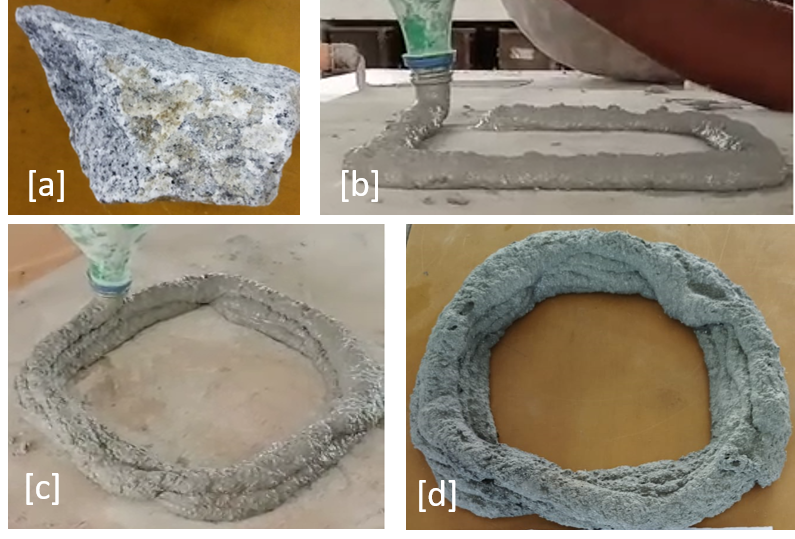3D printing the Sittampundi anorthosite - Indian lunar soil simulant
- 1Vellore Institute of Technology, Vellore, India
- 2Government Arts and Science College, Salem, India
- 3L&T Constructions B&F IC, Chennai, India
- 4Italian Institute of Technology, Pontedera, Italy
- 5Physical Research Laboratory, Ahmedabad, India (jayakrishna@prl.res.in,bhala@prl.res.in)
If we are going to colonize the moon, then we must be in a position to build stable structures on-site and manufacture needed items with the resources that are available on the lunar surface/subsurface. Currently, we are limited by the amounts of lunar soil to research and explore the necessary technologies prior to colonization. Therefore, we need to look at the best analogues available as lunar simulants. Perhaps, such efforts have been made in the past [1] and recently new lunar simulants are also being produced in the laboratory [2]. Indeed, our understanding of building structures by 3D printing using lunar simulants is limited so far, and much more needs to be explored.
Sittampundi anorthosite complex in South India is reported to be the most appropriate lunar simulant [3] and has been used in bio-cementation studies [4]. We collected more than 100 kg of the anorthosite rock samples from Sittampundi as raw material. After grinding the sand corresponded to IS383 zone II (medium sand) with Fineness Modulus 3.16 and fine aggregate 5 mm down. For initial studies, the raw material composite was prepared with water, cement, class-F ultra fine fly ash, superplasticizer, viscosity modifier, and polypropylene microfiber were then added to the anorthosite sample in varying proportions.
The slurry obtained by mixing the seven ingredients including the lunar simulant was then poured into an empty plastic canister. The slurry was manually pressed to extrude layer by layer to produce a 240 mm dia, 40 mm wide, and 31 mm thick structure from four layers. After 14 days of curing and drying process at nominal atmospheric conditions, the strength of the layered 3D printed structure was found to be 39 N mm-2. In this session, we will present more details of the slurry preparation including the proportions of the ingredients used, the 3D printing technique employed, and its implications for future lunar exploration/colonization.

Figure 1: [a] The anorthosite sample before grinding and [b] and [c] the first layer and after three layers of the 3D printed structure, respectively, and [d] printed structure (240 mm dia, 40 mm wide and 31 mm thick) after 14 days.
References:
[1]Hargraves, R.B. and Buddington, A.F., 1970. “Analogy between anorthosite series on the Earth and Moon”. Icarus, 13(3), pp.371-382.
[2]Jäggi, N., Galli, A., Wurz, P., Biber, H., Szabo, P.S., Brötzner, J., Aumayr, F., Tollan, P.M.E. and Mezger, K., 2021. “Creation of Lunar and Hermean analogue mineral powder samples for solar wind irradiation experiments and mid-infrared spectra analysis”. Icarus, p.114492.
[3] Venugopal, I., Muthukkumaran, K., Sriram, K.V., Anbazhagan, S., Prabu, T., Arivazhagan, S. and Shukla, S.K., 2020. “Invention of Indian Moon Soil (Lunar Highland Soil Simulant) for Chandrayaan Missions”. International Journal of Geosynthetics and Ground Engineering, 6(4), pp.1-9.
[4] Dikshit, R., Dey, A., Gupta, N., Varma, S.C., Venugopal, I., Viswanathan, K. and Kumar, A., 2021. “Space bricks: From LSS to machinable structures via MICP”. Ceramics International, 47(10), pp.14892-14898.
How to cite: Budholiya, S., Krishnamoorthy, V., Bhat, A., Venugobal, T., Subramanian, K. L., Narayan, S. L., Babu, S. P. M., Sivaprahasam, V., Bhardwaj, A., Meka, J. K., and Sivaraman, B.: 3D printing the Sittampundi anorthosite - Indian lunar soil simulant, European Planetary Science Congress 2021, online, 13–24 Sep 2021, EPSC2021-535, https://doi.org/10.5194/epsc2021-535, 2021.

